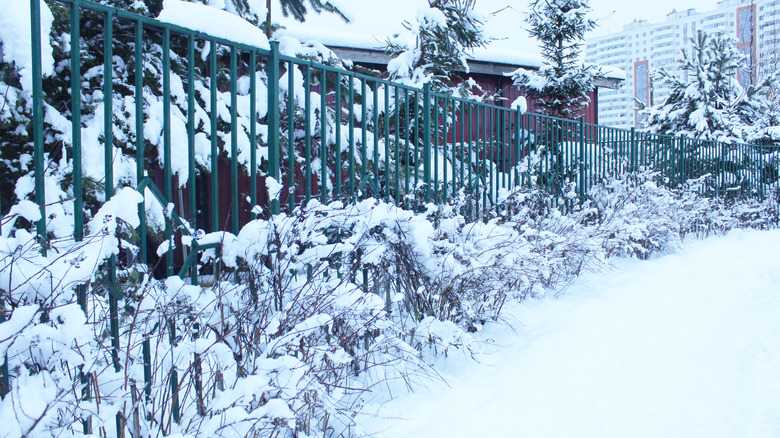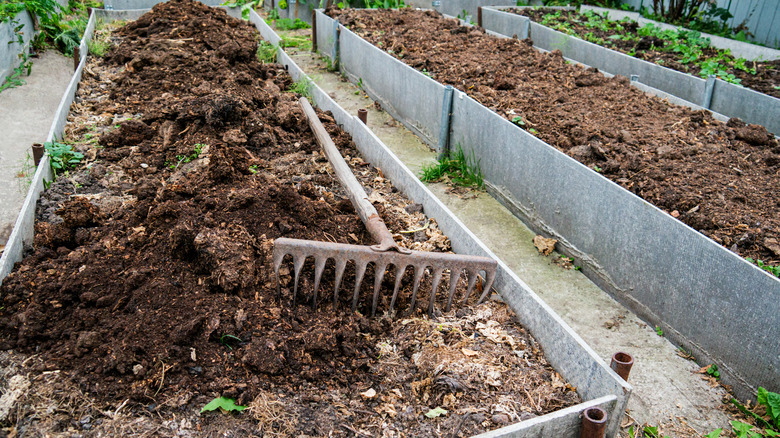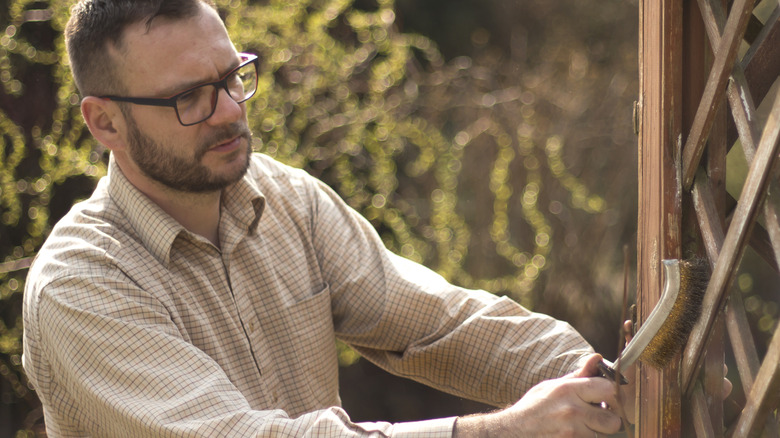The Overlooked Part Of Winter Garden Clean Up You're Forgetting
When you are caring for a garden, there is something to do every season. From planting and pruning in the spring to harvesting and cleaning in the fall, a gardener's to-do list is always filled with one task or another. In the winter, the end-of-season cleanup takes priority. Preparing your raised garden beds for the winter so they're ready for next spring falls into this category. However, there might be one related but less common chore you're likely overlooking: cleaning and sanitizing the plant support structures you use in those garden beds. The cages, trellises, or stakes you plunge into garden soil — which is full of plant roots, microorganisms, and fertilizers — get contaminated.
That's not necessarily a bad thing, but it could be. If the soil contains fungal, bacterial, or viral diseases and dormant pests (eggs or larvae), they can cling to dirty garden accessories. No matter what type of trellis you use in your vegetable garden or flower beds, if you don't clean it before storing or reusing it, you could transfer potentially harmful contaminants to garden tools, equipment, supplies, and, importantly, future plants. The same goes for any other non-permanent structures you move around the garden and use from season to season. Bonus: Cleaning these structures can also prolong their lifespan, keep them looking good, and prevent damage in coming years.
Which raised garden bed accessories should you clean in the winter?
Among the many tips for growing a healthy garden, using clean tools, equipment, and structures tops the list. Which items exactly should you clean when clearing out a raised garden bed in the winter? The simple answer: clean everything. Any accessories that were embedded in the soil for the growing season or came into contact with plant matter — living or dead — should be removed from the bed, brushed or scrubbed clean, and sanitized. That last chore is vital. Most gardeners remember to clear spent annuals, fallen leaves, weeds, and the pruned branches of perennials from their raised beds in the winter, but sanitation is often overlooked.
Those large trellises you used to grow climbing vegetables like beans, melons, cucumbers, or squash should be cleaned completely and stored away somewhere dry for next season. That includes any metal or wooden stakes that held the trellis in the ground, were used as garden markers, or supported plants in the raised garden bed. Clean and disinfect your tomato cages from top to bottom, too. Don't forget about any small reusable items, like plant labels. Unless you do a no-dig garden, you also need to clear out, clean, and sanitize the entire garden bed frame to kill any pests or diseases that may be lingering in the structure.
How to sanitize garden structures to stop disease and pest spread
Before you start your winter garden bed structure clean-up, check the accessories for damage and make any necessary repairs. Then, set up a quarantine area in a part of your garden that's well away from your beds, like a paved patio. There, you can clean and sanitize your plant-growing accessories before putting them away in storage until spring. This will help prevent any contamination from pests, fungal spores, or harmful viruses and bacteria in one area and limit cross-contamination. Then, prepare your cleaning tools. You'll need a garden hose, a soft brush, and possibly some mild soap or detergent. Clean each garden accessory by hosing them down and scrubbing off any stuck-on dirt with the brush. Use soapy water if the structures are particularly dirty.
When they're dry, you can move onto the next stage: disinfection. Depending on your personal preferences and the types of materials your equipment is made of, you may want to use specific disinfectants. For example, diluted bleach is a go-to product for disinfecting garden bed frames between seasons. Hydrogen peroxide can remove bacterial and viral pathogens from garden bed accessories. Wear protective equipment like gloves and goggles when handling these products. If you prefer to avoid bleach in favor of more natural options, 70% rubbing alcohol is effective for killing diseases, insect eggs, and weed seeds. After disinfecting your structures, apply WD-40 to anything made from metal (once it's thoroughly dry) to prevent rust.


